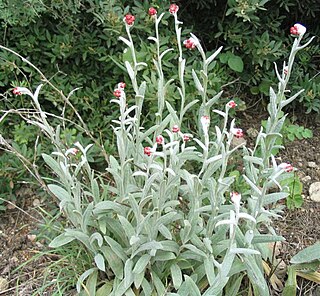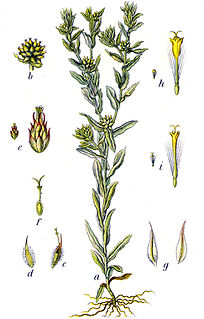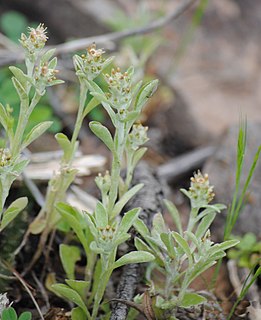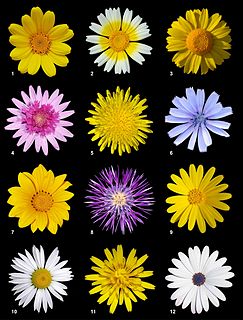
The genus Helichrysum consists of an estimated 600 species of flowering plants in the sunflower family (Asteraceae). The type species is Helichrysum orientale. The name is derived from the Greek words ἑλίσσω and χρῡσός.

Ixobrychus is a genus of bitterns, a group of wading bird in the heron family Ardeidae. Ixobrychus is from Ancient Greek ixias, a reed-like plant and brukhomai, to bellow.

Atriplex is a plant genus of 250–300 species, known by the common names of saltbush and orache. It belongs to the subfamily Chenopodioideae of the family Amaranthaceae s.l.. The genus is quite variable and widely distributed. It includes many desert and seashore plants and halophytes, as well as plants of moist environments. The generic name originated in Latin and was applied by Pliny the Elder to the edible oraches. The name saltbush derives from the fact that the plants retain salt in their leaves; they are able to grow in areas affected by soil salination.

Filago vulgaris or Filago germanica, commonly known as common cudweed or common cottonrose, is an annual herbaceous plant of the genus Filago. It is in the tribe Inuleae of the sunflower family, Asteraceae. Common names also include: Danish—Kugle-museurt, and Norwegian—Kuleullurt.

Gnaphalium palustre, known by the common name western marsh cudweed, is a species of flowering plant in the daisy family.

Herniaria is a genus of flowering plants in the pink family known generally as ruptureworts. They are native to Eurasia and Africa but several species have been widely introduced to other continents. These are flat, mat-forming annual herbs. The genus gets its scientific and common names from the once-held belief that species could be used as an herbal remedy for hernias.

Hesperevax is a small genus of flowering plants in the Inuleae tribe of the daisy family.
Palustris is a Latin word meaning "swampy" or "marshy", and may refer to:

Helichrysum luteoalbum is commonly known as Jersey cudweed or cat's paw.
Jersey cudweed is a common name for several plants and may refer to:

Pseudognaphalium is a genus of flowering plants in the sunflower family.

Euchiton is a genus of flowering plants in the daisy family. They are native to Australasia and the Pacific. Some have been introduced far outside their native ranges.

Isolepis cernua is a species of flowering plant in the sedge family known by the common names low bulrush, slender club-rush, tufted clubrush, and fiberoptic grass. It is widespread, being native to many regions of the world, including parts of Australasia, Eurasia, Africa, and North and South America.

Rorippa palustris is a species of flowering plant in the mustard family. It is widespread and native to parts of Africa, and much of Asia, Europe and Eurasia, North America and the Caribbean. It can also be found in other parts of the world as an introduced species and a common weed, for example, in Australia and South America. It is an adaptable plant which grows in many types of damp, wet, and aquatic habitat. It may be an annual, biennial, or perennial plant, and is variable in appearance as well.

Isolepis setacea is a species of flowering plant in the sedge family known by the common names bristle club-rush and bristleleaf bulrush. It is native to Eurasia and Africa, and possibly Australasia. It can be found in other places, including some areas in North America, where it is an introduced species. It grows in many types of moist and wet habitat, often in coastal regions, and sometimes inland. It is a perennial herb which forms mats of very thin, grooved, erect or arching stems up to about 20 centimeters tall. The leaves sheath the stem bases and have short, flat, thick blades. The inflorescence is a solitary spikelet just a few millimeters long, or a cluster of up to three spikelets. These are accompanied by a stiff bract extending past the flowers.
Tebenna gnaphaliella, the everlasting tebenna moth, is a moth of the family Choreutidae. It is found from Florida to California and north at least to New Hampshire.

Gamochaeta pensylvanica, called Pennsylvania cudweed or Pennsylvania everlasting, is a widespread species of flowering plant in the sunflower family. It is native to South America and introduced into Eurasia, Africa, Australia, and North America. The pensylvanica epithet is a misnomer, as the plant is not native to Pennsylvania and only marginally naturalized there.
This page is based on this
Wikipedia article Text is available under the
CC BY-SA 4.0 license; additional terms may apply.
Images, videos and audio are available under their respective licenses.

















